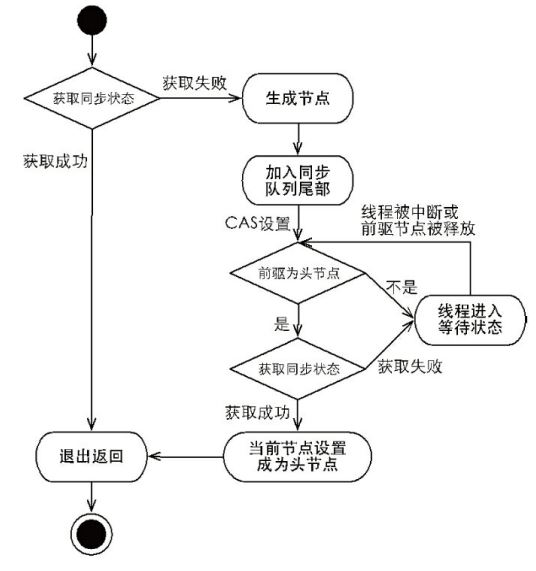独占锁核心源码分析

1. acquire—获取入口
public final void acquire(int arg) {
//获取锁成功,则返回
//反之,加入队列,等待竞争
if (!tryAcquire(arg) &&
acquireQueued(addWaiter(Node.EXCLUSIVE), arg))
selfInterrupt();
}
1.1 tryAcquire——尝试获取
/**
* Fair version of tryAcquire. Don't grant access unless
* recursive call or no waiters or is first.
*/
protected final boolean tryAcquire(int acquires) {
final Thread current = Thread.currentThread();
int c = getState();
if (c == 0) {//未同步时,
//如果不需要入队
if (!hasQueuedPredecessors() &&
compareAndSetState(0, acquires)) {
setExclusiveOwnerThread(current);
return true;
}
}
//同步状态被占用时,判断是否可重入
else if (current == getExclusiveOwnerThread()) {
int nextc = c + acquires;
if (nextc < 0)
throw new Error("Maximum lock count exceeded");
setState(nextc);
return true;
}
return false;
}
1.2 addWaiter——生成节点
/**
* Creates and enqueues node for current thread and given mode.
*
* @param mode Node.EXCLUSIVE for exclusive, Node.SHARED for shared
* @return the new node
*/
private Node addWaiter(Node mode) {
Node node = new Node(Thread.currentThread(), mode);
// Try the fast path of enq; backup to full enq on failure
//尾指针
Node pred = tail;
if (pred != null) {
//新节点的前驱
node.prev = pred;
//CAS更新尾指针(注,这个地方不一定会成功)
if (compareAndSetTail(pred, node)) {
//连接后继
pred.next = node;
return node;
}
}
//尾指针为空,或者CAS失败--》则创建等待队列
enq(node);
return node;
}
1.3. enq——节点入队尾
- spin
- 第一次创建链表头结点
- 第二次更新节点。
/**
* Inserts node into queue, initializing if necessary. See picture above.
* @param node the node to insert
* @return node's predecessor
*/
private Node enq(final Node node) {
for (;;) { //自旋
Node t = tail;
if (t == null) { // Must initialize
// 新建一个头结点,头指针和尾指针一样
if (compareAndSetHead(new Node()))
tail = head;
} else {
node.prev = t;
//设置尾指针,CAS成功,则返回t
if (compareAndSetTail(t, node)) {
t.next = node;
return t;
}
}
}
}
1.4 acquireQueued——等待队列中自旋获取
/**
* Acquires in exclusive uninterruptible mode for thread already in
* queue. Used by condition wait methods as well as acquire.独占非中断模式获取锁,针对已经在等待队列里面的节点。
*
* @param node the node
* @param arg the acquire argument
* @return {@code true} if interrupted while waiting
*/
final boolean acquireQueued(final Node node, int arg) {
boolean failed = true;
try {
boolean interrupted = false;
for (;;) { //自旋
//获取前驱
final Node p = node.predecessor();
//如果是前驱是头结点,说明node要做好准备了,尝试获取
if (p == head && tryAcquire(arg)) {
//成功:设置当前节点为头结点
setHead(node);
//释放直接的头结点
p.next = null; // help GC
failed = false;
return interrupted;
}
//判断是否要park,park函数是将当前调用Thread阻塞,
//而unpark函数则是将指定线程Thread唤醒。即让出CPU。
//park检查和中断检查
//如果可以的话,则进行Park,并更新中断标记
if (shouldParkAfterFailedAcquire(p, node) &&
parkAndCheckInterrupt())
interrupted = true;
}
} finally {
//如果失败,则取消获取
if (failed)
cancelAcquire(node);
}
}
1.5 shouldParkAfterFailedAcquire——获取不到是否应该park
/**
* Checks and updates status for a node that failed to acquire.
* Returns true if thread should block. This is the main signal
* control in all acquire loops. Requires that pred == node.prev.
*
* @param pred node's predecessor holding status
* @param node the node
* @return {@code true} if thread should block
*/
private static boolean shouldParkAfterFailedAcquire(Node pred, Node node) {
//前驱等待状态
int ws = pred.waitStatus;
if (ws == Node.SIGNAL)
/*
* This node has already set status asking a release
* to signal it, so it can safely park.
*/
//所谓安全停靠点,指的是,当前结点的前驱结点waitStatus = -1(SIGNAL),下一个就是它了。
return true;
if (ws > 0) {
//跳过所有已取消的前驱节点
do {
node.prev = pred = pred.prev;
} while (pred.waitStatus > 0);
pred.next = node;
} else {
/*
* waitStatus must be 0 or PROPAGATE. Indicate that we
* need a signal, but don't park yet. Caller will need to
* retry to make sure it cannot acquire before parking.
*/
//如果前节点不处于取消状态,则设为signal -1
compareAndSetWaitStatus(pred, ws, Node.SIGNAL);
}
return false;
}
1.6 parkAndCheckInterrupt
private final boolean parkAndCheckInterrupt() {
LockSupport.park(this);//阻塞该线程,至此该线程进入等待状态,等着unpark和interrupt叫醒他
return Thread.interrupted();//叫醒之后返回该线程是否在中断状态, 并会清除中断记号。
}
1.7 cancelAcquire——取消获取
private void cancelAcquire(Node node) {
if (node == null)
return;
//擦除线程
node.thread = null;
// Skip cancelled predecessors
//跳过已取消的前驱
Node pred = node.prev;
while (pred.waitStatus > 0)
node.prev = pred = pred.prev;
// predNext is the apparent node to unsplice. CASes below will
// fail if not, in which case, we lost race vs another cancel
// or signal, so no further action is necessary.
Node predNext = pred.next;
//取消
node.waitStatus = Node.CANCELLED;
//最后一个节点,设置队尾
if (node == tail && compareAndSetTail(node, pred)) {
compareAndSetNext(pred, predNext, null);
} else {
// If successor needs signal, try to set pred's next-link
// 如果后继需要唤醒,尝试连接
// so it will get one. Otherwise wake it up to propagate.
int ws;
//前驱不是头结点 && 前驱已经SIGNAL,或者即将是
if (pred != head &&
((ws = pred.waitStatus) == Node.SIGNAL ||
(ws <= 0 && compareAndSetWaitStatus(pred, ws, Node.SIGNAL))) &&
pred.thread != null) {
Node next = node.next;
if (next != null && next.waitStatus <= 0)
compareAndSetNext(pred, predNext, next); //连接起来
} else {
//唤醒后继
unparkSuccessor(node);
}
node.next = node; // help GC
}
}
2.7 unparkSuccessor——唤醒后继
/**
* Wakes up node's successor, if one exists.
*
* @param node the node
*/
private void unparkSuccessor(Node node) {
/*
* If status is negative (i.e., possibly needing signal) try
* to clear in anticipation of signalling. It is OK if this
* fails or if status is changed by waiting thread.
*/
int ws = node.waitStatus;
if (ws < 0)
compareAndSetWaitStatus(node, ws, 0);
/*
* Thread to unpark is held in successor, which is normally
* just the next node. But if cancelled or apparently null,
* traverse backwards from tail to find the actual
* non-cancelled successor.
*/
Node s = node.next;
if (s == null || s.waitStatus > 0) {
s = null;
for (Node t = tail; t != null && t != node; t = t.prev)
if (t.waitStatus <= 0)
s = t;
}
//从后面开始找到非取消的后继,
//unPark这个后继
if (s != null)
LockSupport.unpark(s.thread);
}
2.8 release——释放锁
//AQS的release
public final boolean release(int arg) {
if (tryRelease(arg)) {
Node h = head;
if (h != null && h.waitStatus != 0)
unparkSuccessor(h);//唤醒后继节点
return true;
}
return false;
}
//c=0,才完全
protected final boolean tryRelease(int releases) {
//同步状态
int c = getState() - releases;
//当前线程要一致
if (Thread.currentThread() != getExclusiveOwnerThread())
throw new IllegalMonitorStateException();
boolean free = false;
if (c == 0) {
free = true;
setExclusiveOwnerThread(null);
}
setState(c);
return free;
}